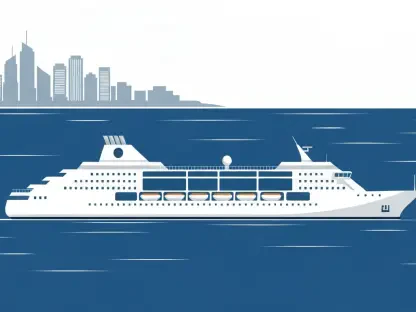Katarina Railko, renowned for her expertise in hospitality, shares her insights on JetBlue’s latest expansion to Traverse City, Michigan. Her experience in travel and tourism provides a unique perspective on how this new route can benefit both the local economy and travelers. With her understanding of the industry, Katarina delves into the strategic decisions and impacts JetBlue’s new service may have.
How did JetBlue decide on Traverse City as a new destination?
JetBlue likely saw a great opportunity in connecting to a destination like Traverse City, which has a unique appeal, especially in the summer. With its beautiful coastlines and vibrant culture, it’s an up-and-coming spot for travelers looking for somewhere new and refreshing. An airline would weigh the potential demand for a tourist-friendly location balanced with the current availability of flights.
What factors contributed to the decision to launch summer-seasonal flights between Boston and Traverse City?
Given Traverse City’s popularity as a summer getaway, it makes sense for JetBlue to introduce flights during this peak period. Seasonal flights allow airlines to tap into heightened demand without committing to year-round service, which might not be sustainable. By matching supply with demand, JetBlue can attract a healthy flow of passengers while maintaining flexibility.
How does the new service benefit New England travelers?
New England travelers now have a direct route to explore the beauty and attractions of Northern Michigan, which might have been more challenging to access before. Having direct flights reduces travel time and costs, making it a more appealing choice for vacationers considering new destinations for their summer trips.
In what ways will this route enhance connectivity for Northern Michiganders?
For residents in Northern Michigan, this new service opens up easy access to Boston and beyond. JetBlue’s extensive network from Boston means that Michiganders can conveniently travel to a wide range of domestic and international destinations, enhancing connectivity for both business and leisure travel.
Can you elaborate on JetBlue’s mission to connect travelers to unique and underserved destinations?
JetBlue aims to serve destinations that aren’t as heavily trafficked, offering travelers something a bit different from the usual tourist routes. By focusing on these niches, they can fill a gap in the market where travelers are eager to explore new places, and in turn, bring economic and cultural exchange to these locations.
How does this new route support the local visitor economy in Northern Michigan?
Bringing more visitors to Traverse City stimulates the local economy, as these travelers will engage in various activities—staying in hotels, dining at restaurants, and visiting local attractions. This influx of tourism can support local businesses and even lead to more job opportunities in the region.
In what ways does JetBlue’s service reflect its commitment to building the best East Coast leisure network?
JetBlue’s focus on adding destinations like Traverse City to its roster reflects a strategy to broaden its offering for leisure travelers. By diversifying its routes and tapping into markets with potential, JetBlue strengthens its position as a key player on the East Coast, offering passengers more varied choices for travel.
Can you share any information on customer feedback regarding JetBlue’s services and routes?
While I don’t have specific data, customer feedback generally indicates satisfaction with JetBlue’s onboard experience, such as their comfortable cabins, free Wi-Fi, and entertainment options. Passengers appreciate these amenities, which likely contribute to loyalty and positive reviews.
Why does JetBlue prioritize its presence in Boston as part of its network strategy?
Boston serves as a significant hub for JetBlue, allowing them to efficiently manage and expand their flight network. With its strategic location and large passenger base, Boston offers JetBlue the opportunity to connect New England to broader international and domestic destinations, which is central to their growth objectives.
Could you discuss JetBlue’s recent service expansions to Boston, including new international destinations?
Recently, JetBlue has expanded its international offerings from Boston, adding destinations such as Madrid and Edinburgh. This expansion underscores their ambition to cater to a variety of travel needs, whether customers are seeking leisure trips or traveling for business, and strengthens Boston as a gateway to Europe.
What are some unique highlights of Traverse City that make it an attractive destination for summer travelers?
Traverse City is encapsulated by its scenic beauty, like the vast landscapes of Sleeping Bear Dunes and the charm of its coastal setting along Lake Michigan. The city’s vibrant food and drink scene, supported by local wineries and breweries, along with its renowned cherry orchards, offer a distinctive experience for visitors, especially during the summer months.
How does Cherry Capital Airport view the addition of JetBlue’s service in terms of regional growth?
The inclusion of JetBlue is seen as a significant step towards regional growth. It not only improves travel options for residents but also attracts more visitors to the region, supporting local tourism and economic development. It positions the airport as a more prominent hub in the area.
Can you explain the features and amenities available on JetBlue’s A220 aircraft for passengers?
JetBlue’s A220 aircraft are designed for comfort and convenience, offering spacious seating, fast and free Fly-Fi internet, and seatback entertainment systems. These features enhance the flying experience, ensuring travelers can enjoy their journey as part of their overall travel adventure.
What potential future opportunities does JetBlue see in expanding flights to other Midwestern destinations?
JetBlue might look to broaden its reach across the Midwest by assessing other cities with growing tourism and business travel markets, similar to Traverse City. Such opportunities would allow JetBlue to serve more communities while satisfying consumer demand in lesser-known yet vibrant areas.
Could you discuss the importance of tourism and connectivity for the economic growth of Traverse City?
Tourism is essential for Traverse City. It fuels economic activity by drawing visitors who spend on lodging, dining, and entertainment. Moreover, improved connectivity broadens business opportunities, enabling the region to attract events and conferences, which further stimulate the local economy.









